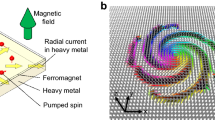Abstract
Two types of formation of super spirals by spiral counter- and co-intertwining of spiral molecular strings were identified using chiral biomimetics. An earlier statement on the formation of hierarchies of super-spiral structures with an alternating chirality sign in molecular homochiral systems was experimentally proven. By developing the Euler model, estimates of forces and velocities in systems of interacting spiral structures that quantitatively correspond to the characteristic times and dimensions of intracellular and inter-cellular interactions were theoretically obtained. It was shown that the phase of structure formation in the cell is not limiting and the time of formation of intracellular structures is determined by the time that is necessary for the cell to choose a functional program.
Similar content being viewed by others
References
B. Alberts, A. Johnson, J. M. Lewis, M. Raff, K. Roberts, and P. Walter, Molecular Biology of the Cell (Oxfam Books, Shrewsbury, United Kingdom, 2002).
R. B. Dickinson and D. L. Purich, “Nematode sperm motility: Nonpolar filament polymerization mediated by end-tracking motors,” Biophys. J. 92(2), 622–631 (2007).
I. Connell, W. Agace, P. Klemm,M. Schembri, S. Marild, and C. Svanborg, “Type 1 fimbrial expression enhances Escherichia coli virulence for the urinary tract. II,” Proc. Nat. Acad. Sci. USA 93(18), 9827–9832 (1996).
J. S. Mattick, “Type IV pili and twitching motility,” Ann. Rev. Microbiol. 56(1), 289–314 (2002).
J. Izraelashvili, Intermolecular and Surface Forces (Moscow, 2011) [in Russian].
A. R. Borges, M. Hyacinth, M. Lum, C. M. Dingle, P. L. Hamilton, M. Chruszcz, L. Pu, M. Sabat and K. L. Caran, “Self-assembled thermoreversible gels of nonpolar liquids by racemic propargylic alcohols with fluorinated and nonfluorinated aromatic rings,” Langmuir 24, 7421–7431 (2008).
X. Qiu, W. Meng, and F. Qing, “Synthesis of fluorinated amino acids,” Tetrahedron 60(32), 6711–6745 (2004).
G. K. S. Prakash, M. Mandal, S. Schweizer, N. A. Petasis, and G. A. Olah, “A facile stereocontrolled synthesis of anti-alpha-(trifluoromethyl)-beta-amino alcohols,” Organic Lett. 2(20), 3173–3176 (2000).
Y. Xu, C. Kang, Y. Chen, Yang Xu, Chuanqing Kang, Yu Chen, Zheng Bian, Xuepeng Qiu, Lianxun Gao and Qingxin Meng, “In situ gel-to-crystal transition and synthesis of metal nanoparticles obtained by fluorination of a cyclic β-aminoalcohol gelator,” Chem.-Eur. J. 18(52), 16955–16961 (2012).
S. V. Stovbun, “Formation of wirelike structures in dilute solution of chiral compounds,” Russ. J. Phys. Chem. B 5, 546–553 (2011).
S. V. Stovbun and A. A. Skoblin, “Molecular and supramolecular structures in biological fluids and their homochiral models,” Mos. Univ. Phys. Bull. 67(3), 274–277 (2012), DOI:10.3103/S0027134912030150). http://vmu.phys.msu.ru/abstract/2012/3/12-3-35
S. V. Stovbun, A. M. Zanin, A. A. Skoblin, A. I. Mikhailov, and A. A. Berlin, “Phenomenological description of the spontaneous formation of macroscopic strings in low-concentration chiral solutions and the formation of anisometric gels,” Dokl. Phys. Chem. 442, 36–39 (2012).
S. V. Stovbun, A. M. Zanin, A. A. Skoblin, A. I. Mikhailov, R. G. Kostyanovskii, M. V. Grishin, and B. R. Shub, “Macroscopic chirality of strings,” Russ. J. Phys. Chem. B 5, 1019–1022 (2011).
S. V. Stovbun, A. A. Skoblin, A. M. Zanin, M. V. Grishin, B. R. Shub, Yu. M. Ageev, G. G. Shishkin, and V. A. Tverdislov, “Superspiralization of Chiral Strings,” Bull. Exper. Biol. Med. 154, 34–36 (2012).
S. V. Stovbun and A. A. Skoblin, “Physicochemical simulation of cell-cell commutation,” Bull. Exper. Biol. Med. 152, 571–574 (2012).
S. V. Stovbun, A. I. Mikhailov, A. A. Skoblin, E. E. Bragina, and M. A. Gomberg, “On the supramolecular mechanism of cell-cell commutation,” Russ. J. Phys. Chem. B 6, 60–64 (2012).
V. A. Tverdislov, “Chirality as a primary switch of hierarchical levels in molecular biological systems,” Biophysics 58, 128–132 (2013).
V. A. Tverdislov, http://arxiv.org/abs/1212.1677
J. R. McIntosh, V. Volkov, F. I. Ataullakhanov, and E. L. Grishchuk, “Tubulin depolymerization may be an ancient biological motor,” J. Cell Sci. 15(123), 3425–3434 (2010).
S. V. Stovbun, Doctoral Dissertation in Mathematics and Physics, (Inst. Khim. Fiz. Ross. Akad. Nauk, Moscow, 2013).
D. M. Zlenko and S. V. Stovbun, “Model of a homochiral supramolecular string,” Russ. J. Phys. Chem. B 8, 613–619 (2014). http://link.springer.com/journal/volumesAndIssues/11826
S. V. Stovbun and A. A. Skoblin, “Optical effect estimation in chiral solutions,” Khim. Fiz. 31(7), 7–11 (2012).
S. V. Stovbun and A. A. Skoblin, “Chirotropical phenomena in biological fluids and their homochiral models,” Mos. Univ. Phys. Bull. 67(3), 278–281 (2012). DOI:10.3103/S0027134912030162). http://vmu.phys.msu.ru/abstract/2012/3/12-3-39
I. I. Artobolevskii, Theory of Mechanisms and Machines. A Tutorial for Higher Techn. Educat. Inst. (Moscow, 1988) [in Russian], 4th ed.
S. V. Stovbun, A. A. Skoblin, and A. M. Zanin, “Structural dynamics of chiral strings,” Russ. J. Phys. Chem. B 8, 293–301 (2014). http://link.springer.com/journal/volumesAndIssues/11826
L. D. Landau and E. M. Lifshits, Course of Theoretical Physics. Vol. 6: Fluid Mechanics (London: Pergamon, 1959; Moscow, 1988).
S. V. Stovbun, A. A. Skoblin, A. M. Zanin, D. P. Shashkin, A. A. Berlin, and V. A. Tverdislov, “Commensurability effects in chiral strings,” Dokl. Phys. Chem. 450, 138–141 (2013).
Physical Values, Ed. by I. S. Grigor’ev and E. Z. Meilikhov, (Moscow, 1991) [in Russian].
L. A. Blumenfeld and A. N. Tikhonov, Biophysical Thermodynamics of Intracellular Processes. Molecular Machines of the Living Cell (Springer-Verlag, New York, 1994).
Author information
Authors and Affiliations
Corresponding author
Additional information
Original Russian Text © S.V. Stovbun, A.A. Skoblin, J.A. Litvin, M.G. Mikhaleva, V.A. Tverdislov, 2015, published in Vestnik Moskovskogo Universiteta. Fizika, 2015, No. 1, pp. 45–50.
About this article
Cite this article
Stovbun, S.V., Skoblin, A.A., Litvin, J.A. et al. Interactions of helical structures as a molecular basis of intra- and intercellular interactions. Moscow Univ. Phys. 70, 45–50 (2015). https://doi.org/10.3103/S0027134915010105
Received:
Accepted:
Published:
Issue Date:
DOI: https://doi.org/10.3103/S0027134915010105




